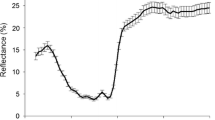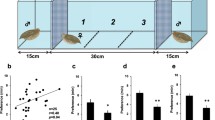Abstract
A salient feature of many secondary sexual characteristics in animals is that their expression is controlled by sex-steroid hormones. However, for only a few types of ornaments do we know the precise molecular mechanism by which androgens like testosterone (T) enhance trait production. We studied the red carotenoid-based beak of male zebra finches (Taeniopygia guttata), which serves as a sexually selected trait and is thought to be T dependent. In previous research, we demonstrated that the extent to which male finches produce lipoproteins in the bloodstream, which bind carotenoid pigments acquired from the diet and transport them to peripheral tissues, regulates the accumulation of carotenoids in the body and beak pigmentation. Here we show that T acts to upregulate lipoprotein production and allows male zebra finches to display flashy, sexually attractive coloration. Levels of circulating T in blood positively and significantly predicted lipoprotein profile (as measured by cholesterol levels), blood carotenoid concentration, and beak color. Exogenous T administration elevated cholesterol and carotenoid status as well as beak redness. Last, experimental inhibition of T (using the anti-androgen flutamide) downregulated lipoprotein production and carotenoid circulation and faded the beak. This androgen- and lipoprotein-mediated system represents one of the more detailed physiological mechanisms underlying the development of a sex-steroid-dependent trait in animals.



Similar content being viewed by others
References
Adkins-Regan E, Wade J (2001) Masculinized sexual partner preference in female zebra finches with sex-reversed gonads. Horm Behav 39:22–28
Adkins-Regan E, Abdelnabi M, Mobarak M, Ottinger MA (1990) Sex steroid levels in developing and adult male and female zebra finches (Poephila guttata). Gen Comp Endocrinol 78:93–109
Allen PC (1987) Effect of Eimeria acervulina infection on chick (Gallus domesticus) high density lipoprotein composition. Comp Biochem Physiol 87B:313–319
Andersson M (1994) Sexual selection. Princeton University Press, Princeton
Angel A, Farkas J (1974) Regulation of cholesterol storage in adipose tissue. J Lipid Res 15:491–499
Ball GF, Riters LV, Balthazart J (2002) Neuroendocrinology of song behavior and avian brain plasticity: multiple sites of action of sex steroid hormones. Front Neuroendocrinol 23:137–178
Balthazart J, Absil P, Flasse V, Ball GF (1994) Effects of the aromatase inhibitor R76713 on sexual-differentiation of brain and behavior in zebra finches. Behaviour 131:225–260
Bhasin S, Woodhouse L, Storer TW (2003) Androgen effects on body composition. Growth Hormone IGF Res 13:S63–S71
Black SM, Harikrishna JA, Szklarz GD, Miller WL (1994) The mitochrondrial environment is required for activity of the cholesterol side-chain cleavage enzyme cytochrome P450scc. Proc Natl Acad Sci U S A 91:7247–7251
Blount JD, Metcalfe NB, Birkhead TR, Surai PF (2003) Carotenoid modulation of immune function and sexual attractiveness in zebra finches. Science 300:125–127
Bottjer SW, Hewer SJ (1992) Castration and antisteroid treatment impair vocal learning in male zebra finches. J Neurobiol 23:337–353
Brinton EA (1996) Oral estrogen replacement therapy in postmenopausal women selectively raises levels and production rates of lipoprotein A-I and lowers hepatic lipase activity without lowering the fractional catabolic rate. Arterioscler Thromb Vasc Biol 16:431–440
Brush AH (1978) Avian pigmentation. In: Brush AH (ed) Chemical zoology, vol. X. Academic Press, New York, pp 141–161
Buchanan KL, Evans MR, Goldsmith AR, Bryant DM, Rowe LV (2001) Testosterone influences basal metabolic rate in male house sparrows: a new cost of dominance signaling? Proc R Soc Lond B 268:1337–1344
Büchter D, Behre HM, Kliesch S, Chirazi A, Nieschlag E, Assmann G, von Eckardstein A (1999) Effects of testosterone suppression in young men by the gonadotropin releasing hormone antagonist cetrorelix on plasma lipids, lipolytic enzymes, lipid transfer proteins, insulin, and leptin. Exp Clin Endocrinol Diabet 107:522–529
Burley N, Coopersmith CB (1987) Bill color preferences of zebra finches. Ethology 76:133–151
Campeau L, Lesperance J, Bilodeau L, Fortier A, Guertin MC, Knatterud GL (2005) Effect of cholesterol lowering and cardiovascular risk factors on the progression of aortoiliac arteriosclerosis: a quantitative cineangiography study. Angiology 56:191–199
Cynx J, Nottebohm F (1992) Testosterone facilitates some conspecific song discriminations in castrated zebra finches (Taeniopygia guttata). Proc Natl Acad Sci U S A 89:1376–1378
Davis RA (1997) Evolution of processes and regulators of lipoprotein synthesis: from birds to mammals. J Nutr 127:S795–S800
Dobs AS, Miller S, Neri G, Weiss S, Tate AC, Shapiro DR, Musliner TA (2000) Effects of simvastatin and pravastatin on gonadal function in male hypercholesterolemic patients. Metab Clin Exp 49:115–121
Evans MR, Goldsmith AR, Norris SRA (2000) The effects of testosterone on antibody production and plumage coloration in male house sparrows (Passer domesticus). Behav Ecol Sociobiol 47:156–163
Folstad I, Karter AJ (1992) Parasites, bright males and the immunocompetence handicap. Am Nat 139:603–622
Fox HM, Vevers G (1960) The nature of animal colors. Macmillan, New York
Gonzalez G, Sorci G, Smith LC, de Lope F (2001) Testosterone and sexual signalling in male house sparrows (Passer domesticus). Behav Ecol Sociobiol 50:557–562
Gordon D, Rifkind BM (1989) Current concepts: high-density lipoproteins—the clinical implications of recent studies. N Engl J Med 321:1311–1315
Hill GE (2002) A red bird in a brown bag: the function and evolution of ornamental plumage coloration in the house finch. Oxford University Press, New York
Jayasooriya AP, Weisinger RS, Weisinger HS, Mathai ML, Sinclair AJ (2002) Attraction to orange: sexiness, not gluttony. Science 296:847
Johnstone RA (1995) Sexual selection, honest advertisement and the handicap principle: reviewing the evidence. Biol Rev 70:1–65
Kimball RT, Ligon JD (1999) Evolution of avian plumage dichromatism from a proximate perspective. Am Nat 154:182–193
Kudzma DJ, Swaney JB, Ellis EN (1979) Effects of estrogen administration on the lipoproteins and apoproteins of the chicken. Biochim Biophys Act 572:257–268
Landschulz KT, Pathak RK, Rigotti A, Krieger M, Hobbs HH (1996) Regulation of scavenger receptor class B type I, a high density lipoprotein receptor in liver and steroidogenic tissues of the rat. J Clin Invest 98:984–995
Langer C, Gansz B, Goepfert C, Engel T, Uehara Y, von Dehn G, Jansen H, Assmann G, von Eckardstein A (2002) Testosterone up-regulates scavenger receptor BI and stimulates cholesterol efflux from macrophages. Biochem Biophys Res Comm 296:1051–1057
Maynard-Smith J, Harper D (2003) Animal signals. Oxford University Press, Oxford
McGraw KJ, Ardia DR (2003) Carotenoids, immunocompetence, and the information content of sexual colors: an experimental test. Am Nat 162:704–712
McGraw KJ, Parker RS (2005) A novel lipoprotein-mediated mechanism controlling sexual attractiveness in a colorful songbird. Physiol Behav (http://doi:10.1016/j.physbeh.2005.09.001) (in press)
McGraw KJ, Dale J, Mackillop EA, Hauber ME (2002a) Different colors reveal different information: how nutritional stress affects the expression of melanin- and structurally based ornamental coloration. J Exp Biol 205:3747–3755
McGraw KJ, Adkins-Regan E, Parker RS (2002b) Anhydrolutein in the zebra finch: a new metabolically derived carotenoid in birds. Comp Biochem Physiol B 132:813–820
McGraw KJ, Gregory AJ, Parker RS, Adkins-Regan E (2003a) Diet, plasma carotenoids and sexual coloration in the zebra finch (Taeniopygia guttata). Auk 120:400–410
McGraw KJ, Dale J, Mackillop EA (2003b) Social environment during molt and the expression of melanin-based plumage pigmentation in male house sparrows (Passer domesticus). Behav Ecol Sociobiol 53:116–122
Mizutani T, Yamada K, Minegishi T, Miyamoto K (2000) Transcriptional regulation of rat scavenger receptor class B type 1 gene. J Biol Chem 275:22512–22519
Mundinger PC (1972) Annual testicular cycle and bill color change in the eastern American goldfinch. Auk 89:403–419
Negro JJ, Figuerola J, Garrido J, Green AJ (2001) Fat stores in birds: an overlooked sink for carotenoid pigments? Funct Ecol 15:297–303
Nelson RJ (2000) An introduction to behavioral endocrinology, 2nd edn. Sinaeur Associates Inc., Sunderland
Parker RS (1996) Absorption, metabolism, and transport of carotenoids. FASEB J 10:542–551
Parker TH, Knapp R, Rosenfeld JA (2002) Social mediation of sexually selected ornamentation and steroid hormone levels in male junglefowl. Anim Behav 64:291–298
Ralph CL (1969) The control of color in birds. Am Zool 9:521–530
Rigotti A, Edelman ER, Seifert P, Iqbal SN, DeMattos RB, Temel RE, Krieger M, Williams DL (1996) Regulation by adrenocorticotropic hormone of the in vivo expression of scavenger receptor class B type I (SR-BI), a high density lipoprotein receptor in steroidogenic cells of the murine adrenal gland. J Biol Chem 271:33545–33549
Ros AFH (1999) Effects of testosterone on growth, plumage pigmentation, and mortality in black-headed gull chicks. Ibis 141:451–459
Schlinger BA (1997) Sex steroids and their actions on the birdsong system. J Neurobiol 33:619–631
Schlinger BA, Schultz JD, Hertel F (2001) Neuromuscular and endocrine control of an avian courtship behavior. Horm Behav 40:276–280
Setchell JM, Dixson AF (2001) Changes in secondary sexual adornments of male mandrills (Mandrillus sphinx) are associated with gain and loss of alpha status. Horm Behav 39:177–184
Stoehr AM, Hill GE (2000) Testosterone and the allocation of reproductive effort in male house finches (Carpodacus mexicanus). Behav Ecol Sociobiol 48:407–411
Stoehr AM, Hill GE (2001) The effects of elevated testosterone on plumage hue in male house finches. J Avian Biol 32:153–158
Tan KCB, Shiu SWM, Kung AWC (1999) Alterations in hepatic lipase and lipoprotein subfractions with transdermal testosterone replacement therapy. Clin Endocrinol 51:765–769
Trams EG (1969) Carotenoid transport in the plasma of the scarlet ibis (Eudocimus ruber). Comp Biochem Physiol 28:1177–1184
Ushiroyama T, Ikeda A, Ueki M (2001) Beneficial effects of pravastatin in peri- and postmenopausal hyperlipidemic women: a 5-year study on serum lipid and sex hormone levels. Maturitas 37:201–208
Wingfield JC, Lynn SE, Soma KK (2001) Avoiding the ‘costs’ of testosterone: ecological bases of hormone-behavior interactions. Brain Behav Evol 57:239–251
Witschi E (1961) Sex and secondary sexual characters. In: Marshall AJ (ed) Biology and comparative physiology of birds, vol 2. Academic Press, New York, pp 115–168
Zann RA (1996) The zebra finch: a synthesis of field and laboratory studies. Oxford University Press, Oxford
Zuk M, Johnsen TS (2000) Social environment and immunity in male red jungle fowl. Behav Ecol 11:146–153
Zuk M, Johnsen TS, Maclarty T (1995) Endocrine-immune interactions, ornaments and mate choice in red junglefowl. Proc R Soc Lond B 260:205–210
Acknowledgements
We thank K. Navara and M. Mendonca for help running T assays; V. Johnson at Polymedco Inc. for answering questions about cholesterol assays; T. van Deusen, D. Sheils, and P. Smith for assistance with animal care; and P. Deviche, R. Parker, and D. Winkler for constructive comments on the manuscript. This research was supported by the National Science Foundation (IBN 9514088 and 0130986 to EAR) and the Environmental Protection Agency (graduate STAR fellowship to KJM). All reported procedures were approved by the Institutional Animal Care and Use Committee at Cornell University (protocol # 99–89).
Author information
Authors and Affiliations
Corresponding author
Additional information
Communicated by I. Hartley
Rights and permissions
About this article
Cite this article
McGraw, K.J., Correa, S.M. & Adkins-Regan, E. Testosterone upregulates lipoprotein status to control sexual attractiveness in a colorful songbird. Behav Ecol Sociobiol 60, 117–122 (2006). https://doi.org/10.1007/s00265-005-0135-3
Received:
Revised:
Accepted:
Published:
Issue Date:
DOI: https://doi.org/10.1007/s00265-005-0135-3




